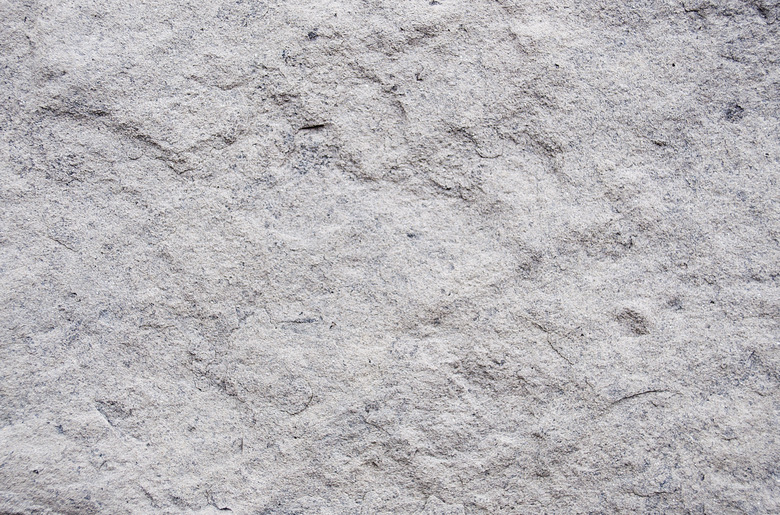Physical Characteristics Of Limestone
Limestone is a collective term for a group of sedimentary rocks that consist of at least 50 percent calcite, a mineral formed of calcium carbonate. If some of the calcium becomes replaced by magnesium, the resulting calcium magnesium carbonate rock is called dolomitic limestone. Limestone has a variety of origins and may be precipitated in water or secreted by marine organisms such as coral; it also may consist of the shells of dead marine organisms.
Clastic and Nonclastic
Clastic and Nonclastic
There are two principal types of sedimentary rock: clastic, or detrital — which is made up of small rock fragments — and nonclastic, also called chemical and inorganic. Clastic limestone is made up of biogenic grains, or clasts, rather than eroded rock fragments, as in the case of sandstones. Such biogenic clasts are shell or bone fragments from dead marine organisms and accumulate by sinking to the bottom of the sea or any other body of water. They also grow in marine environments such as coral reefs. Nonclastic limestone, such as travertines, forms through the precipitation of carbonate crystals in shallow waters and in groundwater, the latter forming stalagmites and stalactites in caves.
Chemical and Mechanical Weathering
Chemical and Mechanical Weathering
Carbon dioxide in the atmosphere, together with sulfur and nitrogen oxides in polluted urban and industrial regions, dissolves in rainwater and groundwater to form weak acids. These acids react with carbonates in the limestone and dissolve the rock, forming sinkholes and caves. Limestone is also subject to mechanical weathering, especially in dry climates, by the abrasive action of wind carrying rock fragments and other debris. This combination of chemical and mechanical weathering makes limestone very vulnerable to deterioration when exposed to the atmosphere.
Porosity and Fractures
Porosity and Fractures
Limestone formed through the accumulation of shells and skeletal material has a high initial porosity — a term referring to the voids between the solid fragments. This porosity decreases with compaction over time as more material is deposited and fragments cement together. Acidic water from the atmosphere or ground dissolves some of this compacted material, creating a secondary porosity. Earth movement over geological time causes the limestone to fracture. Acidic water ingress further enlarges the fractures. When exposed, this dissolution effect appears on the surface as a network of fissures and sinkholes called karst.
Engineering Advantages and Problems
Engineering Advantages and Problems
Limestone formations such as landscapes, caves and coral reefs make spectacular tourist attractions. When used as a building material, limestone has a graceful and attractive ageing process over centuries, despite its vulnerability to deterioration. The high porosity and cavities of limestone makes it an efficient aquifer for public water supplies in Texas, Ireland and worldwide. However, limestone formations present serious engineering problems for road, tunnel and building construction. Cavities and steeply inclined rock layers may not always be identified during a construction site investigation and can subside, causing a sudden collapse of foundations, buildings and tunnels.
References
- The University of Auckland: Limestone
- U.S. General Services Administration: Limestone: Characteristics, Uses and Problems
- Eastern Illinois University: Sedimentary Rocks
- Earth Magazine: Clues to Limestone Weathering Written in Western Wall
- West Virginia University: Carbonate Reservoirs and Fractured Reservoirs
- Geological Survey of Ireland: Importance of Limestone and Karst
- Indiana Limestone Institute of America: About Indiana Limestone: Advantages
- State of Louisiana Department of Natural Resources: Reservoir Rocks
Cite This Article
MLA
Kielmas, Maria. "Physical Characteristics Of Limestone" sciencing.com, https://www.sciencing.com/physical-characteristics-limestone-7608531/. 24 April 2017.
APA
Kielmas, Maria. (2017, April 24). Physical Characteristics Of Limestone. sciencing.com. Retrieved from https://www.sciencing.com/physical-characteristics-limestone-7608531/
Chicago
Kielmas, Maria. Physical Characteristics Of Limestone last modified March 24, 2022. https://www.sciencing.com/physical-characteristics-limestone-7608531/
